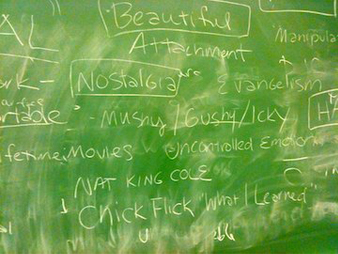
I teach poetry, creative nonfiction, multigenre, and literature courses to graduate students, undergrads, and in the community.
Recent offerings:
The Uses of Rage
Women and femme poets are warned against “losing control” and being “too emotional” by not only male writers but also women. The world will do a lot to unrage a rageful woman, from dismissing her as useless, disruptive, or “merely angry” to outright silencing her. This workshop for women and female-identified writers proposes rage as a rich state for writing. What ways can rage enter and move in a poem? What are the shades of difference between rage and anger, bitterness, outrage? Together we explore rage in the form and content of poems. Our models are poems by a wide range of writers old and new—some touchstones are Audre Lorde, June Jordan, Judy Grahn, Allen Ginsberg—that contain, harness, perform, and meditate on rage.
Hot/Not: Emotion in Innovative Poems
Do experimental poems have feelings? Sol LeWitt said conceptual art is made to engage the mind, not the emotions. Yet innovative and conceptual poems do engage emotion. This course tracks the force of feeling in language play, irony, and conceptual ideas. We explore how innovative and experimental poems take on potentially “hot” topics such as childhood, motherhood, love, sex, and injustice. We uncover the forces that keep experimental poems from being “cold,” and how sentiment, and even sentimentality, work in innovative writing. Recent texts include Sarah Vap, Maggie Nelson, Russell Atkins, Montana Ray, Farid Matuk, Juliana Spahr, Harryette Mullen, Emily Dickinson, Myung Mi Kim, Joanne Kyger, and others.
Somatic Poetry
This workshop welcomes poets to generate new work using the multidisciplinary techniques of somatic poetry. Soma is Greek for body. Quoting poet CA Conrad: Somatic poetry is about “being present in the present, in the body.” Somatic poets use rituals to access the energy of the earth and the universe (some call it the spirit), connect it to our bodies, and make poems of that connection. Somatic exercises may involve sound, color, objects such as rocks or pennies, durations of time (a few seconds, a week, longer), and even food, as a way to the page. Somatic prompts can be especially productive for poets writing from trauma who want to experiment outside of traditional narrative techniques, which can be constricting or force confession. We read work by Bhanu Kapil, CA Conrad, Brenda Ijima, and others. No previous knowledge of somatic practices is necessary.
Inventing Landscape
Landscapes in poems are as complex as real-life forests, cities, edgelands, and subdivisions. In this course we look carefully at poetic landscapes from coast roads to abandoned buildings to floating islands of plastic waste. The idea is to see how writers use landscape to create a sense of inhabitation (in the world and in a poem) and what effect that can have on a reader. Readings move from pastoral poetry through ecopoetics and have included work by Brenda Hillman, Ed Roberson, Lisa Robertson, Theodore Roethke, Hoa Nguyen, Cathy Park Hong, Thoreau, Charles Wright, Major Jackson, Jack Collom, and others.
21st/20th Century Poetry: A Retrospective Reading
This readings class traces contemporary poetic practices back to their roots. We begin with close readings of new books by poets working in a variety of traditions including confessionalism, narrative, and documentary poetics. Then we read an earlier poet, looking for what the writer has taken from traditions of the 1980s, mid-20th century, and earlier. We consider the cultural context of certain poems, given that they are historical artifacts. But we read mainly to understand how poetic language evolves and to perceive our own, individual poetic lineage. Recent texts: Ross Gay, Catalog of Unabashed Gratitude; Bhanu Kapil, The Vertical Interrogation of Strangers; C.D. Wright, One Big Self; Cornelius Eady, Brutal Imagination; Nick Flynn, My Feelings
